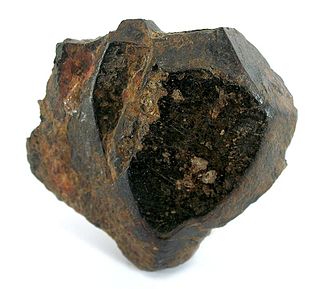Related Research Articles

Sapphire is a precious gemstone, a variety of the mineral corundum, consisting of aluminium oxide (α-Al2O3) with trace amounts of elements such as iron, titanium, cobalt, lead, chromium, vanadium, magnesium, boron, and silicon. The name sapphire is derived via the Latin sapphirus from the Greek sappheiros (σάπφειρος), which referred to lapis lazuli. It is typically blue, but natural "fancy" sapphires also occur in yellow, purple, orange, and green colors; "parti sapphires" show two or more colors. Red corundum stones also occur, but are called rubies rather than sapphires. Pink-colored corundum may be classified either as ruby or sapphire depending on locale. Commonly, natural sapphires are cut and polished into gemstones and worn in jewelry. They also may be created synthetically in laboratories for industrial or decorative purposes in large crystal boules. Because of the remarkable hardness of sapphires – 9 on the Mohs scale (the third hardest mineral, after diamond at 10 and moissanite at 9.5) – sapphires are also used in some non-ornamental applications, such as infrared optical components, high-durability windows, wristwatch crystals and movement bearings, and very thin electronic wafers, which are used as the insulating substrates of special-purpose solid-state electronics such as integrated circuits and GaN-based blue LEDs. Sapphire is the birthstone for September and the gem of the 45th anniversary. A sapphire jubilee occurs after 65 years.

Titanium is a chemical element with the symbol Ti and atomic number 22. Found in nature only as an oxide, it can be reduced to produce a lustrous transition metal with a silver color, low density, and high strength, resistant to corrosion in sea water, aqua regia, and chlorine.

Ilmenite is a titanium-iron oxide mineral with the idealized formula FeTiO
3. It is a weakly magnetic black or steel-gray solid. Ilmenite is the most important ore of titanium and the main source of titanium dioxide, which is used in paints, printing inks, fabrics, plastics, paper, sunscreen, food and cosmetics.

Titanium dioxide, also known as titanium(IV) oxide or titania, is the inorganic compound with the chemical formula TiO
2. When used as a pigment, it is called titanium white, Pigment White 6 (PW6), or CI 77891. It is a white solid that is insoluble in water, although mineral forms can appear black. As a pigment, it has a wide range of applications, including paint, sunscreen, and food coloring. When used as a food coloring, it has E number E171. World production in 2014 exceeded 9 million tonnes. It has been estimated that titanium dioxide is used in two-thirds of all pigments, and pigments based on the oxide have been valued at a price of $13.2 billion.

William Gregor was an English clergyman and mineralogist who discovered the elemental metal titanium.
Goldcorp Inc. was a gold production company headquartered in Vancouver, British Columbia, Canada. The company stood among the largest gold producers in the world, employed about 15,800 people worldwide, engaged in gold mining and related activities including exploration, extraction, processing and reclamation. Goldcorp’s operating assets included eleven mines in North and South America.
San Miguel Ixtahuacán is a municipality in the San Marcos department of Guatemala. It comprises 19 villages, and the population is about 39,000 people. The majority of people are ethnically Maya- Mam and speak the Mam and Spanish languages. Most inhabitants subsist by farming, growing crops of corn, beans, vegetables and fruits, irrigated from the Cuilco River and its tributaries.
William Justin Kroll was a Luxembourgish metallurgist. He is best known for inventing the Kroll process in 1940, which is used commercially to extract metallic titanium from ore.

The use of jade in Mesoamerica for symbolic and ideological ritual was highly influenced by its rarity and value among pre-Columbian Mesoamerican cultures, such as the Olmec, the Maya, and the various groups in the Valley of Mexico. Although jade artifacts have been created and prized by many Mesoamerican peoples, the Motagua River valley in Guatemala was previously thought to be the sole source of jadeite in the region.
The Xinka, or Xinca, are a non-Mayan indigenous people of Mesoamerica, with communities in the southern portion of Guatemala, near its border with El Salvador, and in the mountainous region to the north.

Tahawus was a village in the Town of Newcomb, Essex County, New York, United States. It is now a ghost town situated in the Adirondack Park. Tahawus is located in Essex County within the unpopulated northern area designated to the town of Newcomb. Tahawus was the site of major mining and iron smelting operations in the 19th century. Although standing as recently as 2005, the last mining facilities have since been demolished and removed.
Titanium mining in Africa has been beset by environmental problems due to the polluting nature of processing rutile, a principal titanium ore. Titanium production in Africa includes the following principal countries and companies.

Kenmare Resources plc is a publicly traded mining company headquartered in Dublin, Republic of Ireland. Its primary listing is on the London Stock Exchange and it has a secondary listing on Euronext Dublin. Kenmare is one of the world's largest mineral sands producers and the Company owns and operates the Moma Titanium Minerals Mine. Moma is one of the world's largest titanium minerals deposits, located 160 km from the city of Nampula in Mozambique.
Sierra de las Minas is a mountain range in eastern Guatemala, extending 130 km west of the Lake Izabal. It is 15–30 km wide and bordered by the valleys of the rivers Polochic in the north and the Motagua in the south. Its western border is marked by the Salamá River valley which separates it from the Chuacús mountain range. The highest peak is Cerro Raxón at 3,015 m. The Sierra's rich deposits of jade and marble have been mined throughout the past centuries. These small scale mining activities also explain the name of the mountain range.

Iluka Resources is an Australian-based resources company, specialising in mineral sands exploration, project development, operations and marketing. Iluka is the largest producer of zircon and titanium dioxide–derived rutile and synthetic rutile globally. Iluka mines heavy mineral sands and separates the concentrate into its individual mineral constituents rutile, ilmenite, and zircon. Some of the ilmenite is then processed into synthetic rutile.
QIT-Fer et Titane is a Canadian mining company located in Quebec. The company operates an ilmenite mine at Lake Tio in northern Quebec, and in southern Quebec operates refining facilities that produce titanium dioxide, pig iron, steel, and other metal products. The company is a wholly owned subsidiary of mining giant Rio Tinto Group.
Richards Bay Minerals (RBM) is a South African mining company. RBM's principal product is titanium dioxide in the form of an 85% pure titanium dioxide slag; the company also produces the higher-purity 95% titanium dioxide product rutile as well as pig iron and zircon.
Robert G. Terzuola is an American knife maker who popularized the type of knife known as the tactical folding knife.

The Tellnes mine is one of the largest titanium mines in Europe. The mine is located about 4 kilometres (2.5 mi) northeast of the Jøssingfjorden in Sokndal municipality in Rogaland county, Norway. The mine has reserves amounting more than 300,000,000 tonnes of ore grading 18% titanium. The deposit of titanium was discovered in 1954 and production at the mine began in October 1960. Each year there is about 2,000,000 tonnes of ore and 1,600,000 tonnes of rock waste removed from the open-pit mine. This resulted in about 580,000 tonnes of ilmenite concentrate from the mine in 1999.
The mineral industry of Guatemala includes:
References
- 1 2 3 Guatemala mineral and mining sector. 2012. ISBN 9781433021046 . Retrieved 2013-06-28.